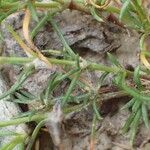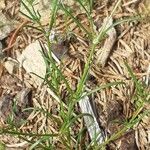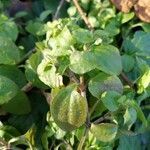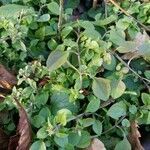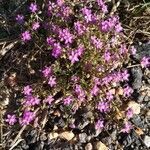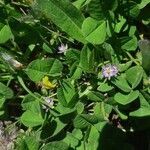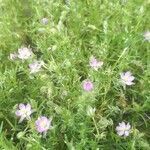Herb, annuals, biennials or short-lived perennials, with slender to woody taproot. Branches decumbent from base. Leaves prominently caudate, 4–25 mm long, 0.4–1.2 mm wide, glabrous or glandular-hairy. Stipules acute to acuminate, frequently furcate, (2.5–) 3.5–5 mm long, connate for much less than half their length, usually prominently silvery. Inflorescence many-flowered, leafy, with dense glandular hairs 0.15–0.25 (–0.4) mm long. Pedicels longer than sepals, much longer than capsules. Sepals ovate-lanceolate, 3–4 mm long (mostly 3.5–5 mm long in fruit); dark purple basal spots obscure or absent. Petals 2.4–3.8 mm long, uniformly pink or lilac. Stamens (5–) 10. Capsules ovoid, 4–5.5 mm long, equal to or slightly (rarely more than 0.5 mm) longer than sepals. Seeds broadly pyriform to semicircular in outline, 0.4–0.55 (–0.6) mm long, dark purple-, blackish-or grey-brown, rugulose-colliculate/tuberculate to papillate, wingless.
Annual to perennial herb; taproot sometimes stout. Stems decumbent to ascending or erect, (2)-5-15-(30) cm long. Lvs fascicled, not fleshy, linear, mucronate, (2)-4-10-(15) × 0.5-0.8 mm, glabrous or with glandular hairs. Stipules silvery, shortly connate, not forming a sheath, lanceolate, acute, 3-4.5 × 1.5-2 mm. Infl. a racemoid monochasium, many-flowered, with glandular hairs. Pedicels (2)-4-9 mm long, mostly > sepals, with glandular hairs. Sepals obtuse to subacute, (2.5)-3-4 mm long, with glandular hairs; margin scarious. Petals purplish pink, < sepals. Stamens (4)-7-10. Capsule c. = sepals. Seeds subtrigonous to semicircular, brown, not winged, finely papillate, 0.45-0.5 mm long.
Herbs annual, sometimes perennial. Taproot slender, sometimes ± woody. Stems diffuse, decumbent or procumbent, 20--25 cm, branched at base, apically glandular pubescent. Leaves fasciculate, 5--20 × 0.5--1 mm, glabrous or pubescent; stipules silvery, lanceolate, apex acuminate. Cymes sparse; bracts nearly as large as leaves. Sepals lanceolate, 3--4.5 mm. Petals uniformly pink, obovate, equaling or shorter than sepals. Stamens (5 or)10. Capsule 4--5 mm, ca. equaling calyx. Seeds dark brown, subtrigonous, small, tuberculate, unwinged. Fl. May--Jul, fr. Jul--Oct. 2n = 18, 27, 36, 54.
Simple or much-branched annual or short-lived perennial, prostrate or ascending, 5–30 cm, glabrous or sparsely glandular-hairy above; lvs linear-filiform, mucronate, scarcely fleshy, 3.5–35 × 0.4–1.2 mm; stipules triangular-acuminate, 2.5–5 mm; sep 3.5–5 mm, lanceolate; pet consistently pink, shorter than the sep; stamens (6–)10; fr 3.5–5 mm; seed 0.4–0.6 mm, papillate, wingless; 2n=36, 54. Native of Europe, intr. as a weed in sandy or gravelly soil from Nf. to Mich., Wis., and B.C., s. to Md., Ala., N.M., and Calif. May–Sept. (Tissa r.)
An annual herb. It can continue growing for some years. It grows 5-20 cm high. It often lies along the ground. The leaves are 3-10 mm long and 1 mm wide. They are narrow and sword shaped. There are membrane like stipules near the base of the leaves. The flowers are pink and about 5 mm across. They are clustered at the ends of stems. The seeds do not have wings.
Sprawling annual or perennial from slender taproot, up to 200 mm tall. Leaves opposite and in axillary tufts, linear. Flowers in open cymes, uniformly pink or lilac, sepals 3-4 mm long. Seeds not winged, dark brown.
Sprawling annual or perennial, from slender taproot, up to 0.20 m high. Leaves opposite, linear. Flowers in open cymes, pink or lilac; sepals < 4 mm long. Flowering time Sept.-Dec. Seeds not winged.
Sprawling annual or perennial from slender taproot, to 20 cm. Leaves opposite, linear. Flowers in open cymes, pink or lilac, sepals < 4 mm. Seeds not winged.
